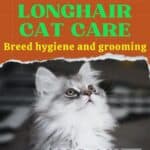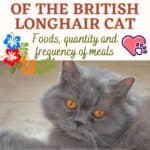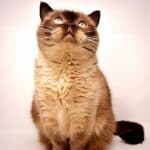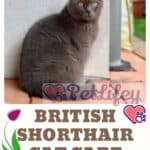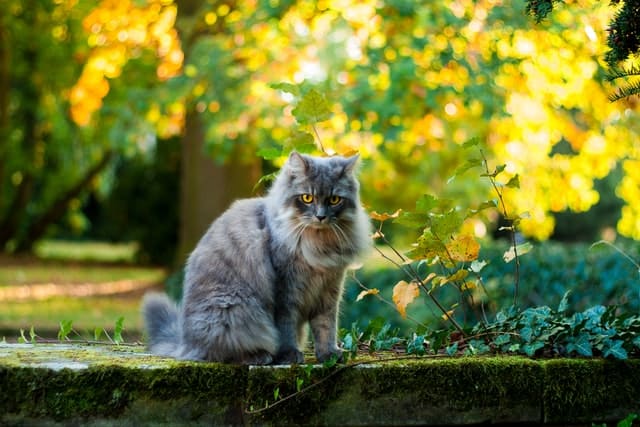
Do not be fooled by his somewhat stocky side because the British longhair is a curvaceous and gentle cat, both for his silky hair and his character. Very easy-going, very sociable, like its cousin the shorthair, the British longhair is an excellent companion!
The origins of the British Longhair cat
The British shorthair cat, originally from England, is also sometimes called Highland Straight, or “lowlander” in the United States. The British longhair is the cousin of the British shorthair, so their history is closely linked.
The British longhair is born from a first of a cross between the shorthair and the Persian. Indeed after the First World War, while cats suffered from war like humans, the breed dwindled. The English then decide to mix the British Shorthair with cats without pedigree to reconstitute the breed. But the cat lacks the characteristic roundness of the British Shorthair. Also, to bring this roundness, they decide to crossbreed with Persian. This is how the gene for long hair appears.
Long disowned, hidden, the British longhair was only recognized very recently (in 2000 for France). However, he remains discreet and rare compared to his cousin with short hair, which makes him a rather original cat!
The ideal cat
The British longhair cat is medium to long in size, stocky with wide hips and shoulders. Its back is short and well muscled, its paws strong with round feet, and its tail is short and thick in the shape of a brush.
Its head is robust and massive with a round face. It has two large round eyes, spaced enough apart must have a color in harmony with the coat (green, pr, blue, odd depending on the color of the coat). Its nose is broad and round, and should not resemble Persian. Its skull is rounded, and its two small ears are set wide apart with rounded ends.
A thick ruff surrounds its neck, with a lighter colored hair on the chest. Its hair is denser near the head and hind legs.
Hair color
We find the same wide color palette as for the British shorthair. All colors are recognized, whether they are plain ones like cream, blue, black, lilac, red, chocolate; two-tone (black and white, blue and white, red and white…) or colourpoint such as blue-cream, seal, red, chocolate and lilac. There are also British longhairs with patterns such as tortie and tabby.
The character
The British longhair inherited the calm and composed character of its cousin. Very present without being intrusive, it is adapted to modern life, and always offers beautiful moments of serenity to the master who will know how to bring him the love and gentleness he needs. Affectionate but also playful in it’s spare time, the British longhair is a cat who is close to their master.
Her light, even slender meow is in stark contrast to her stocky and muscular body!
Hug:
Soft, touching and warm, it’s always nice to snuggle up near this teddy bear!
Player:
Although the British Longhair is powerful and muscular, it does not have a reputation for being a particularly active cat.
Calm:
Its heavy structure and thick coat justify its appreciation of relaxation sessions! It can be happy as an indoor cat, especially if their environment is enriched with heights, cat trees and hiding places that allow him to carry out stimulating activities.
Smart:
The Highland Straight is curious and quick-witted!
Fearful / Suspicious of Strangers:
It certainly enjoys the company of humans they knows. When introduced to new people, it’s best to take your time and respect your limits.
Independent:
Their calmness helps them tolerate loneliness. It is imperative, however, to offer them enough stimulation so that it does not get bored.
Behaviour
Talkative:
The Highland Straight meows little and with a charming little voice!
Greedy / glutton:
A certain tendency to gluttony is known to them. However, offering this cat its kibble in interactive bowls keeps it occupied and limits its portions, while forcing it to eat more slowly.
Need for exercise:
Interactive play sessions are perfect for keeping him in shape and developing a wonderful relationship with them.
Runaway:
Even if it is quite a homebody, it also possesses the curiosity characteristic of all cats. Better to be vigilant.
Compatibility
The British Longhair and Dogs:
Properly educating dogs and cats helps in building healthy relationships. It is imperative to introduce them gradually to each other while respecting their rhythm. It is also necessary to ensure that the cat has spaces of its own, whether in height or in hiding places, to withdraw.
The British Longhair and Other Cats:
Pacifist and tolerant, they adapt easily to the presence of other cats. Taking the time to gradually introduce cats to each other helps them build a positive relationship with each other. By respecting a method of gradual introduction, we increase our chances of success!
The British Longhair and the Children:
The softness and the teddy side of this cat has something to attract children! It will be very tender and peaceful, even with young children, however, it is important to educate them, from an early age, to understand the body language of the cat, to guide them in the development of a relationship. healthy for all.
The British Longhair and the Elderly:
Quiet cat, it could very well be suitable for a calm person, if it is able to provide for their needs for physical stimulation.
Maintenance
Grooming:
Regular brushing is essential to remove dead hair from the Highland Straight and to ensure that knots do not form, as its felt coat tends to lump.
Hair loss:
During the spring moult, hair loss is marked. Thus, it is better to get your cat used to frequent grooming sessions, in order to make these moments peaceful and pleasant.
Food
A quality diet, adapted to their level of activity, their age and their medical requirements, is essential. Because it has a heavy build, the British Longhair can be prone to overweight. Following the recommendations of a veterinarian for the nutritional needs of his cat helps promote his health.
Cares
Its mid-length coat, soft as mohair, requires regular maintenance without being abusive. Its coated hair does not form many knots and allows easy brushing. We will pay a little more attention to its fur in winter, the moulting period.
Health
Life expectancy:
Its longevity is on average 14 to 18 years .
Resistant / robust:
Its long and dense fur protects it from cold and bad weather.
Tendency to
gain weight : Rather quiet and contemplative, the Highland Straight has a propensity to gain weight. By offering his food in interactive bowls, playing with him every day and following the advice of his veterinarian team, he is allowed to stay active and healthy.
Common Illnesses:
The British Longhair can suffer from the same illnesses as other domestic cats, such as those associated with oral health. In addition, it is important to be attentive to the development of these pathologies:
Neonatal erythrolysis is more often diagnosed in the British Longhair than in other breeds. It is a disease that starts in the newborn and leads to its death
Polycystic kidney disease results in the development of cysts that prevent normal kidney function and lead to kidney failure. An adapted diet can delay the development of the pathology, reduce the symptoms and allow the cat to live longer
Hypertrophic myocaridopathy is a disease that can affect many breeds as well as cats without pedigrees. In the long term, it can cause, in particular, heart failure. Screening is done by echocardiography, which is usually repeated annually. In the event of illness, treatment may be given to alleviate the symptoms.
Reproduction:
Marriages are allowed between British (Longhair and Shorthair). According to the associations, other marriages are sometimes allowed.
The litters are on average 4 kittens.
Good to know
British Longhair is much rarer than the shorthair variety, but is rapidly gaining popularity in Europe and elsewhere in the world!
Price
The price of a British Longhair kitten in breeding is on average between 1068.99 USD and 1425.32 USD. This cost varies among other things according to the line, breeding, age and sex. For the monthly budget, it takes an average of 47.51 USD per month to adequately meet your needs.

